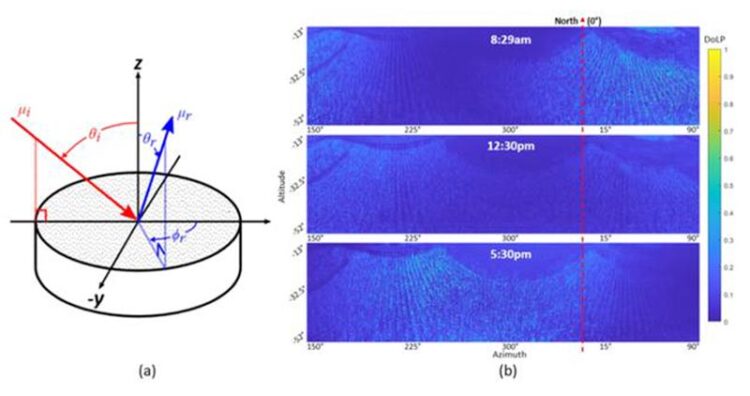Revolutionizing field phenotyping

Presents angular conventions used for BRDF modeling and (b) displays threeexample DoLP images of the field sampled at 8:29am, 12:30pm, and 5:30pm.
Credit: Plant Phenomics
Amidst challenges like a booming global population and diminishing arable land, plant phenotyping offers a way to automate agriculture and improve crop diagnostics. However, translating the precision of controlled-environment phenotyping to field conditions remains a hurdle, particularly in accurately measuring leaf color due to sunlight glare. Existing solutions, ranging from light scattering simulations to 3D sensor fusion, often require complex, time-consuming, or impractical methods.
In March 2024, Plant Phenomics published a research article entitled by “Mitigating Illumination-, Leaf-, and View-Angle Dependencies in Hyperspectral Imaging Using Polarimetry”. This research aims to develop a novel, single-frame glare color correction technique utilizing polarized BRDF models and polarization-sensitive measurements, potentially revolutionizing field phenotyping by addressing the persistent challenge of glare without the need for complex or time-intensive methods.
Initially, pBRDF measurements were performed on two B73 maize plants using SCATMECH models at a wavelength of 550nm, which provided the basis for the creation of a generalized library of mmBRDF models for maize leaves. This foundational step was followed by correction model simulations, where the model processed uncorrected reflectivities and Stokes parameters, and showed that increasing polarisation led to a decrease in the perceived value of the parameter γ. This suggested a potential for correcting high DoLP and erroneous γ values, despite challenges in areas of retroreflection.
Validation of this correction model involved spectral ground truth measurements across a field and comparison between corrected and uncorrected Regions of Interest (ROIs) from low and high DoLP areas. This process confirmed the uniformity of plant behaviour across the field and over time, supporting the assumption of the model. The field trial data also showed that images taken at different times of day varied in their degree of polarization, with the correction model significantly reducing the mean square error (MSE) and standard deviation of the calculated indices, GNDVI and RERR, by significant factors.
The performance of the model was visually and statistically validated using spectropolarimetric image data from a field trial, showing a significant improvement in the accuracy of phenotypic imaging under varying conditions. The error and variance of the image data were significantly reduced, confirming the spectral invariance hypothesis and suggesting the potential applicability of the correction network across different two-band metrics. The research concluded with promising results, indicating that polarimetry could play a crucial role in enhancing the capabilities of multi- and hyperspectral sensor systems for high-throughput phenotyping applications in the field. Future work will focus on extending the model to different maize varieties, assessing the impact of varying weather conditions, and expanding the library of mmBRDF and correction models for broader agricultural applications.
References
Authors
Daniel Krafft1,4*†, Clifton G. Scarboro1,4, William Hsieh1, Colleen Doherty2,4†, Peter Balint-Kurti3,4, and Michael Kudenov1,4
†These authors contributed equally to this work.
Affiliations
1Department of Electrical and Computer Engineering, North Carolina State University, Raleigh, U.S.A.
2Department of Molecular and Structural Biochemistry, North Carolina State University, Raleigh, U.S.A.
3Department of Plant and Microbial Biology, North Carolina State University, Raleigh, U.S.A.
4NC Plant Sciences Initiative, North Carolina State University, Raleigh, U.S.A.
About Daniel Krafft
PhD candidate (exp. grad. summer 2024). His dissertation is on Bidirectional Reflectance Correction using Polarization in Maize Remote Sensing.
Journal: Plant Phenomics
DOI: 10.34133/plantphenomics.0157
Method of Research: Experimental study
Subject of Research: Not applicable
Article Title: Mitigating Illumination-, Leaf-, and View-Angle Dependencies in Hyperspectral Imaging Using Polarimetry
Article Publication Date: 1-Mar-2024
COI Statement: The authors declare that they have no competing interests.
Media Contact
Ping Wang
Nanjing Agricultural University The Academy of Science
pingwang@njau.edu.cn
Office: 86-843-99610
Original Source
All latest news from the category: Agricultural and Forestry Science
Newest articles

A new puzzle piece for string theory research
Dr. Ksenia Fedosova from the Cluster of Excellence Mathematics Münster, along with an international research team, has proven a conjecture in string theory that physicists had proposed regarding certain equations….

Climate change can cause stress in herring larvae
The occurrence of multiple stressors undermines the acclimatisation strategies of juvenile herring: If larvae are exposed to several stress factors at the same time, their ability to respond to these…

Making high-yielding rice affordable and sustainable
Plant biologists show how two genes work together to trigger embryo formation in rice. Rice is a staple food crop for more than half the world’s population, but most farmers…



